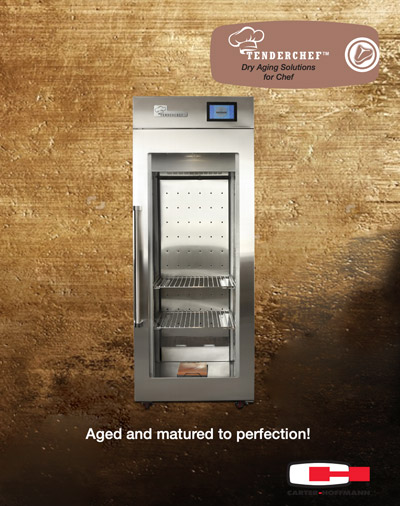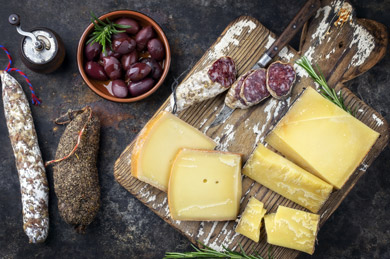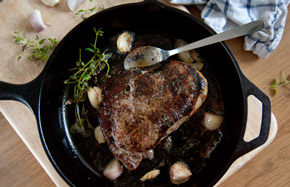Is dry aged meat becoming a staple of fine dining?

Many of the latest trends for 2020 involve using worldly flavors and different cooking techniques to create something unique and elevated, but one method that will always produce a truly fine dining experience is the process of dry-aging meat.
Now some of the finest restaurants in America serve steaks with flavor that is cultivated through special aging processes, sometimes called “old world style.” Its origin dates to the 1950s when butchers discovered it as a way to cure meat through hanging in a refrigerated room and aging it, which makes the beef cuts (mainly from the rib and the loin) more tender and flavorful than it would ever be immediately after slaughtering and butchering.
Wet Vs. Dry Aging
There are two methods for aging beef: wet and dry, but according to tried and true practices, the dry process is what can bring out the most flavorful notes in meat and poultry.
In the dry process, the meat dehydrates, moisture evaporates, and enzymes slowly break down muscle tissue, resulting in a cut that is extremely tender and full of flavor. The downside to this process is that there is a reduction in product due to the moisture loss, which increases the cost per pound. Additionally, the surface of the meat usually needs to be trimmed away before the beef is portioned and served or sold, resulting in further loss of volume.
The present method for dry aging consists of hanging whole, sub-primal chunks of meat (like prime rib and short loin), poultry and curing cheese in a temperature-controlled food curing cabinet. In this process, temperature, humidity, and air flow are imperative to aging a steak properly. Failure to properly age the meat could lead to a loss in profit. But when done correctly, a richness is added to any culinary foodservice operation and provides an extremely unique fine dining experience that will draw in more loyal customers.
Dry aging is both art and science. Meats must be maintained at temperatures between 32- and 39-degrees Fahrenheit (0 to 4 degrees Celsius), at humidity settings between 50-85% and a recommended air flow of 0.5 – 2 m/s or 1.6 – 6.6 ft/s. to ensure optimal weight and trim loss during the aging process. Most tenderization occurs within the first 7 to 10 days of the aging process, when natural enzymes in beef break down connective tissue in the muscle fibers to concentrate the flavor. The entire process takes about 20-40 days. According to bonapetit.com, there are some adventurous chefs in search of new flavors who have tried longer aging times, from 60 to 90 days, among them include Mario Batali and Nicole Brisson.
The dry aging solution for chefs

With dry aging, operators can elevate the classic burger, pan seared steak and even steak tartare. One of the best commercial dry aging and food curing cabinets on the market is the TenderChef made by Carter-Hoffmann.
The TC100 is a one-section, all stainless-steel food curing cabinet that can be used to age beef, poultry, cheese and sausages. With a height of about 80 inches, a width of 30 inches and a depth of 34 inches, the TenderChef can fit in any kitchen or front of the house. It features a hinged glass door with adjustable wire shelving and rack supports, along with a UV disinfecting light and LED light with a timer.
Specifications:
- Temperature set points range from 28°F to 58°F in increments of 1°F, along with an auto defrost cycle.
- Humidity set points range from 60% to 90% and can be controlled in increments of 1%.
- Touchpad controls for temperature, humidity and aging/curing cycles.
- Field-reversable, locking door with magnetic gasket and roller latch; full length tempered glass window and stainless-steel door handle.
- LED light generates the right ambient spectrum to illuminate the environment to showcase your menu without interfering with the aging process.
- Comes with an application for online monitoring and USB port for uploading settings.
The TenderChef by Carter-Hoffmann uses the latest technology in a way that makes it easy to use for operators.
The instructions are simple:
- Set airflow to speed of preference.
- Place product inside cabinet.
- Come back when it’s done.
Dry Aged Steak Recipe

Pan Seared Dry-Aged Steak Recipe (via, Carter-Hoffmann)
Ingredients:
- 1 thick cut of dry-aged steak
- 4 Tbsp unsalted butter
- 1 oz oil
- Freshly ground black pepper
- Kosher salt
- 3 cloves garlic
- 3 cloves garlic
- 1 shallot
- Sea salt flakes for garnish
Directions:
- Preheat oven to 350-400°F.
- Take steak out of the dry aging refrigerator and bring to room temperature and heavily season it with salt and pepper.
- Heat a cast iron skillet on high heat.
- Sear steak on skillet until it develops a nice golden crust.
- Add butter, thyme, garlic and shallots to the pan.
- Flip steak and let sear two minutes until crust forms.
- When butter has melted, baste the steak by using one hand to tilt the pan and the other to rapidly spoon sauce over the meat.
- Place pan with steak into a 350-400 degree oven for approximately 8 minutes (medium rare).
- Once done, remove steak from the skillet and let rest for at least 5-10 minutes.
- Slice steak into thick pieces and top with flaky sea salt before serving.
For more information on the TenderChef dry-aging refrigerator, please contact our knowledgeable sales team who are happy to assist at 404-752-6715 (ext. 2 for sales).
Did you enjoy this article?
Subscribe to stay up to date on industry news and receive exclusive sales and promotions.


